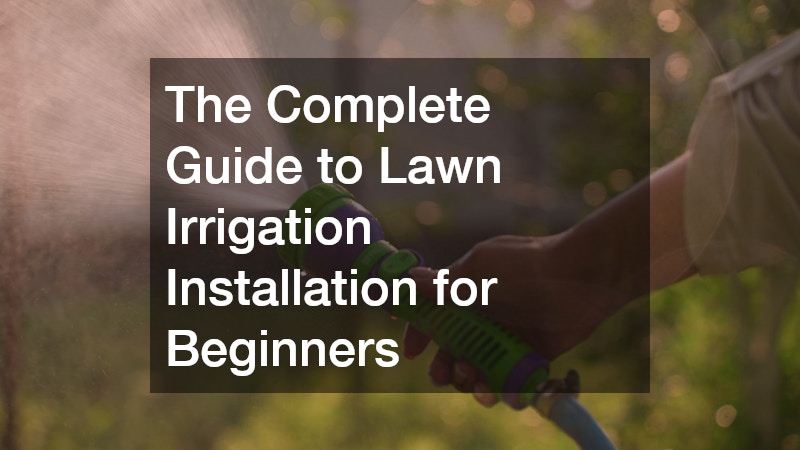In this guide, we’ll walk you through the essentials of lawn irrigation installation. From the initial planning stages to the final touches, we aim to equip beginners with the knowledge needed to achieve a lush and healthy lawn. Whether you’re aiming to conserve water or simply ensure your green space remains vibrant throughout the seasons, understanding the foundational steps of irrigation is crucial for success.
Designing an Efficient Lawn Irrigation System
Assessing Your Lawn’s Needs
Assessing your lawn’s specific needs is the first step in designing an efficient irrigation system. Different areas of your lawn may require varying amounts of water depending on factors such as sunlight exposure and soil type. Monitoring these zones can help you create a system that conservatively delivers the right amount of water without excess waste.
By identifying these zones, you ensure that each section of your lawn receives the appropriate irrigation. For instance, a shaded area behind a wooden fence may need less water compared to sun-drenched sections. Recognizing these distinctions allows you to plan a more efficient and resource-saving irrigation layout.
Moreover, failing to assess the needs properly can lead to inefficiencies such as overwatering, which might hurt your lawn’s health. Setting up a system without consulting the specific needs could lead to increased water bills and potential lawn damage. Thus, a tailored approach to watering will ensure your lawn remains healthy and lush throughout the year.
Choosing the Right Type of Irrigation System
Choosing the right kind of irrigation system is imperative to match your lawn’s requirements. The three main types—drip, sprinkler, and rotor systems—each have unique benefits. Drip irrigation tends to conserve the most water, delivering moisture directly to the plant’s roots, making it ideal for gardens and areas with diverse plant types.
Sprinkler systems, on the other hand, are more suitable for larger expanses of grass. They provide broad coverage and can be adjusted for watering different sections of your yard simultaneously. Rotor systems, often used in bigger landscapes, are more efficient in areas susceptible to wind because they produce larger droplets that are less likely to drift away.
When selecting an irrigation system, consider factors such as water pressure, climate, and installation complexity. Understanding these variables can help you choose a system that will save both water and money while maintaining lawn health. Whether you’re aiming for water conservation or extensive coverage, aligning your choice with functional needs guarantees effectiveness.
Materials and Tools Needed for Installation
Essential Tools and Equipment
Before starting the installation of your lawn irrigation system, gathering all essential tools and equipment is crucial. Key tools include pipe cutters for customizing the length of your pipes, tape measures for precise layout, and trenching tools for digging irrigation paths. Having a well-stocked toolkit ensures that the installation process proceeds smoothly without unnecessary interruptions.
Along with these tools, you will need a sturdy shovel and a garden trowel for more delicate work. A level can also be beneficial to ensure that your spray heads and pipelines are correctly aligned. Having a checklist of required tools can significantly streamline the entire installation process by negating the need for frequent trips to the hardware store.
Shopping for Irrigation Supplies
Shopping for supplies is another important step in setting up an effective irrigation system. Begin by understanding the key components, such as PVC pipes, spray heads, and control valves. It’s recommended to choose durable materials that can withstand different weather conditions to ensure lasting functionality.
Many home improvement stores offer these components, and it’s essential to compare quality and prices before making a purchase. Online platforms also provide extensive options, often with customer reviews that can offer insights into the products’ performance and durability. When buying these supplies, taking the time to research can greatly enhance your irrigation system’s longevity.
Installing Your Lawn’s Irrigation System
Step-by-Step Installation Process
Installing your irrigation system using a structured step-by-step approach enhances precision and efficiency. Begin by mapping out your design on the lawn, using spray paint or stakes to denote where pipes and spray heads will be fitted. Once the design is established, digging trenches provides the necessary framework for laying pipelines.
After trenches are dug, laying pipes according to the mapped design becomes the main focus. Connect the pipes with appropriate fittings and use pipe glue as needed to secure the joints. Placement of spray heads follows, carefully adjusting them for height and angle to ensure optimal lawn coverage.
Testing and Adjusting the System
Once your system is installed, the crucial task of testing and adjusting arises. Initially, turn on the system to monitor each zone, checking for leaks and ensuring that water dispersal meets your lawn’s topographical needs. Undertake this task gradually, allowing for proper pressure management and verifying even water distribution.
Adjustments may involve tweaking spray head angles or swapping out nozzles for more appropriate ones. Frequent evaluation during the first few weeks will help you identify inconsistencies in watering and make the necessary corrections. Reliable testing establishes the system’s durability and efficiency, contributing to a lush, well-maintained lawn.
Installing a lawn irrigation system can seem daunting, but with careful planning and the right tools, it’s an achievable project for any homeowner. By following the steps outlined in this guide, you’ll be well on your way to enjoying a verdant, healthy lawn. Remember that the key to a successful installation lies in understanding your lawn’s needs and choosing the right materials and tools for the job.



